Devon McKendrick
CTVNewsWinnipeg.ca
Published Sept. 20, 2023 4
Manitoba's NDP is on the rise according to new polling numbers released Wednesday.
A Probe Research poll, commissioned by CTV News Winnipeg and the Winnipeg Free Press, shows almost half of decided and leaning voters will support the NDP on election day.
In June, both the NDP and Progressive Conservatives were deadlocked with 41 per cent support. But since then, the PCs dropped to 38 per cent, while the NDP gained ground at 49 per cent. Meanwhile, the Manitoba Liberals are at nine per cent.
Across the province, 11 per cent of people asked say they are undecided.
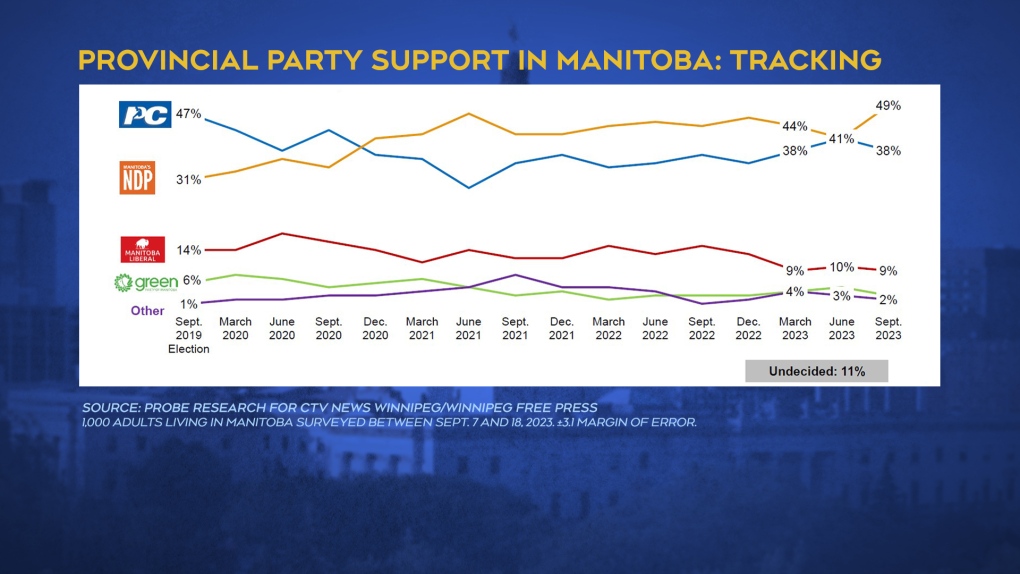
Scott MacKay with Probe Research said the data is pointing to a majority government for the NDP on Oct. 3.
"It really does look that way, especially with the strength in the city," said MacKay.
Those numbers in Winnipeg show the NDP has a massive lead over the incumbent PCs with 57 per cent, compared to 28 per cent. The Liberals have higher results in Winnipeg topping out at 11 per cent.
"The NDP have almost historically high, almost 30 points, between them and the Conservatives. So it's looking like this will be a victory for the NDP and it looks like a majority to me."
A further breakdown highlights the NDP is leading in every single quadrant of the city. The closest race is in the northwest, the NDP has a slight lead at 45 per cent, while the Tories sit at 42 per cent and the Liberals actually have less support than the Green Party – five per cent and six per cent respectively.
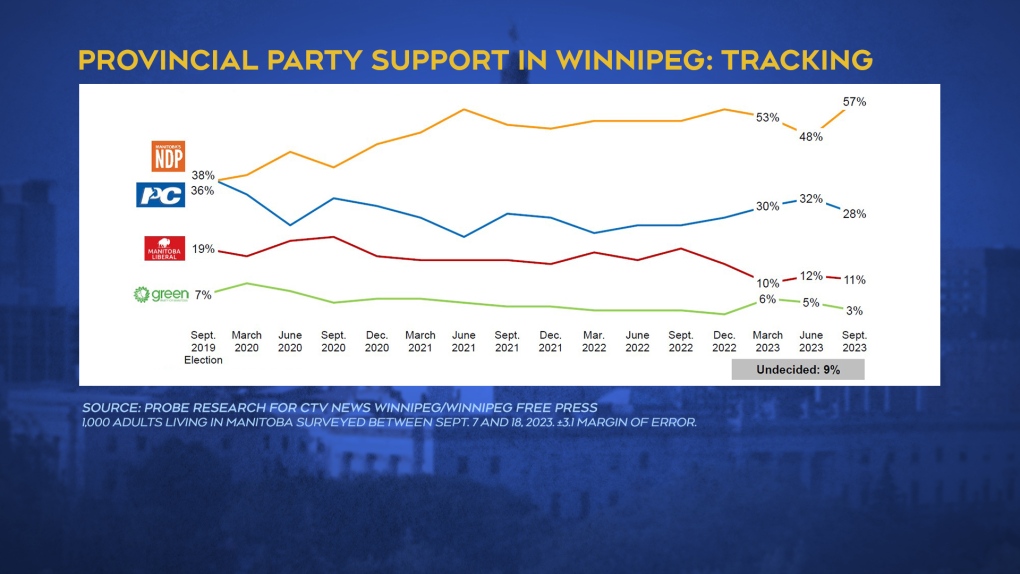
The largest difference in Winnipeg is the city's core with the NDP receiving an overwhelming 68 per cent support. The PCs and Liberals are neck-and-neck for second place – the Conservatives at 15 per cent and the Liberals at 13 per cent.
The northeast is a 60-30 split in favour of the NDP with the Liberals at five per cent.
Both quadrants in south Winnipeg have the NDP sitting at 55 per cent, while the PCs are at 24 per cent in the west and 30 per cent in the east. The Liberals are at 18 per cent in the west and 14 in the east.
MacKay said south Winnipeg was classified as an important area even before the election was called.
"They were seats that were known to be switchable. They were ones that the NDP had held even fairly recently. So I think all eyes were on those regions and today, we see NDP strength in those regions."
Nine per cent of Winnipeggers polled say they are undecided on who they will support.
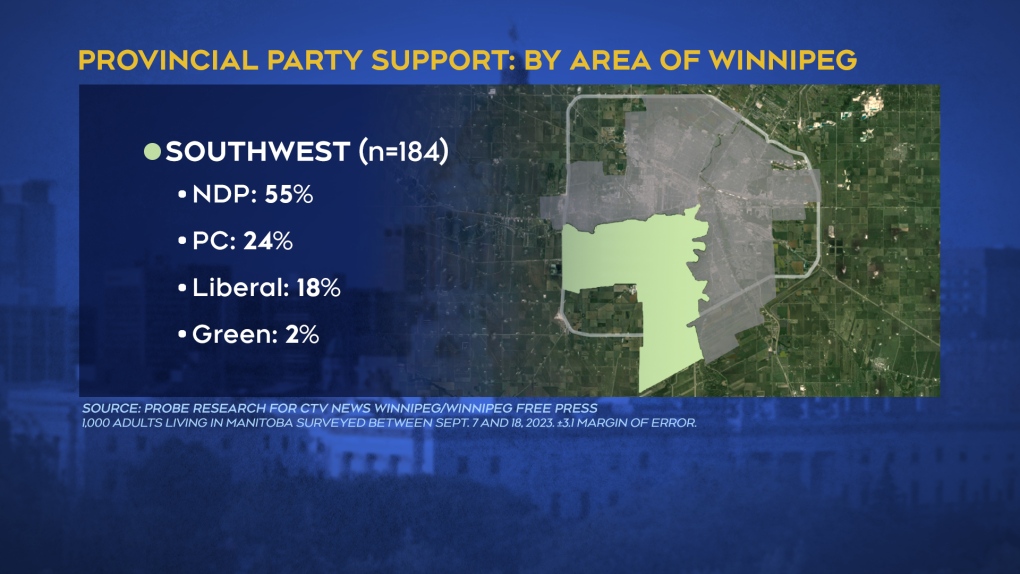
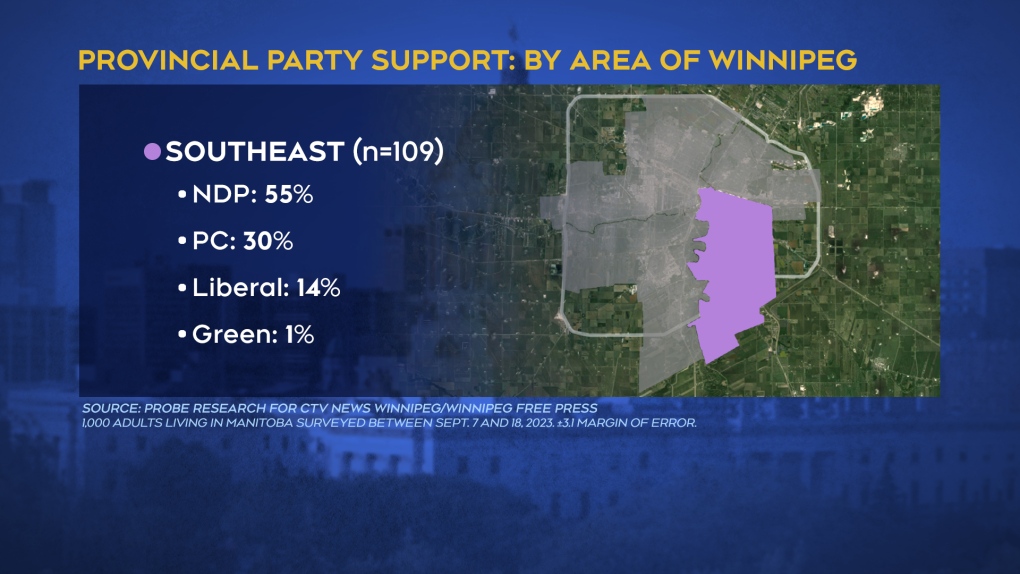
Comparing votes from 2019 could help explain why the NDP are seeing more support.
People were asked who they voted for in 2019 and what they plan to do in this election. Half of people who voted Liberal last election said they will now support the NDP. Another 16 per cent who voted Conservative plan to flip their vote for the NDP.
"The Liberals are an important part of this puzzle of the election because we have them at historically low levels," said MacKay. "I think that this sort of collapse, and I think that's not even too strong a word, of the Liberals, it's really what's helping to deliver this to the NDP."
SUPPORT FOR PARTY LEADERS
As part of the polling, Manitobans were asked if they approve of each party leader's job performance.
The NDP's Wab Kinew is perceived as doing the best job with a 51 per cent approval rating, followed by Liberal Dougal Lamont at 38 per cent.
The PC's Heather Stefanson sits third at 32 per cent. She also has the highest disapproval rating with 48 per cent of Manitobans polled saying they strongly disapprove of her job performance.
A graph showing job performance approval rating based on the results of a Probe Research poll that was commissioned by CTV News Winnipeg and the Winnipeg Free Press. (Source: Probe Research. Sept. 20, 2023)
"She is not a popular leader, and in fact, there's a level of intensity of dislike for Ms. Stefanson that we just don't see with Wab Kinew," MacKay said. "Wab Kinew is the only candidate who really has a positive view of the public. People are more inclined to like him than dislike him and that's not the case for Stefanson."
Kinew was next at 27 per cent strongly disapproved and Lamont was at 20 per cent.
Polled residents also have a better impression of Kinew compared to Stefanson, with the NDP leader going up five points, while Stefanson has dropped 23 points with 38 per cent of people saying they view her either somewhat worse or much worse.
Lamont was able to gain one point but 71 per cent of respondents say they still have the same view of Lamont as before.
VOTER DEMOGRAPHICS
With the NDP receiving more support both in the province and in Winnipeg according to the poll, it isn't a surprise the party also leads in most demographic breakdowns.
The NDP is polling higher with women than men, 59 per cent compared to 38 per cent, while the Conservatives have the lead with men at 47 per cent, but lag with women at 29 per cent.
Each age group has significant support for the NDP; however, it’s the PCs that have the slight lead in the 55-plus category – 44 per cent compared to 43 per cent for the NDP. The Liberals also have their highest support in the 55-plus crowd with 11 per cent.
MacKay said the older population is the one positive the Conservatives can rely on.
"That is a very reliable constituency of voters. So it's possible that they are actually going to hold this vote, such as it is, and that some of the NDP support, which is among younger voters are not actually going to vote. So that is something that they will be thinking about."
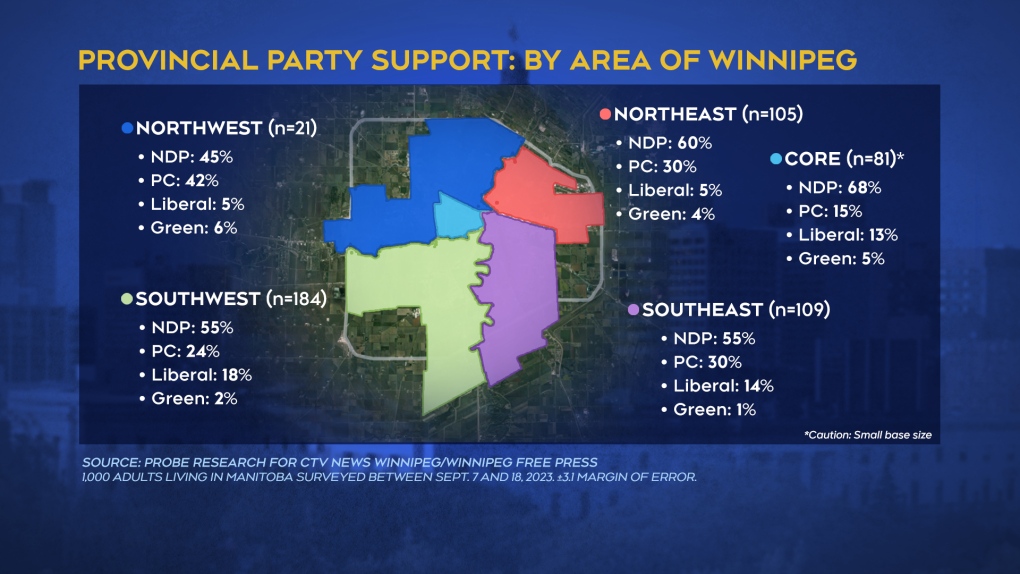
It doesn't matter what income bracket Manitobans fall under either, as the NDP hovers around the 50 per cent mark for all three categories, while the PCs range from 31 to 38 per cent support.
University graduates also prefer the NDP compared to the Conservatives with a 62-27 per cent split.
However, those who went to college or any other post-secondary, prefer the PCs at 44 per cent, slightly more than the NDP at 42 per cent. High school education or less also favours the Conservatives over the NDP.
The Liberals sit under the 10 per cent mark in all categories.
Lastly, those who identify as Indigenous or BIPOC are strongly in favour of the NDP.
MacKay wants to remind people that these numbers are not final and situations could change between now and when people head to the polls.
"There is still time, there's going to be significant events, including the debate tomorrow…those can be a turning point. So, it's not over until it's over and there's two weeks left. Who knows what people might have up their sleeve? But this is a good snapshot of where we're at, at this late point of the campaign."
In an emailed statement to CTV News, an NDP spokesperson said, "Since this campaign began, Wab Kinew has been saying that Manitoba needs a change in Government so we can repair our health-care system. This poll suggests a growing number of Manitobans agree. We have been working to earn a mandate from the people of Manitoba and will continue to work hard until election day."
Marni Larkin, the PC campaign manager, said these numbers aren't concerning for the party.
"I have to say I'm a little bit surprised by them because it's certainly not what we're seeing at the door," she said. "I just need to think about the seats I need to win and I feel really confident in those seats. We're just going to keep our head down and get it done."
CTV News Winnipeg did reach out to the Manitoba Liberals and is awaiting a response.
The Probe polling took place between Sept. 7 and 18, 2023. Researchers talked to 1,000 people throughout the province during that time and said with 95 per cent certainty that the margin of error is ±3.1 percentage points.
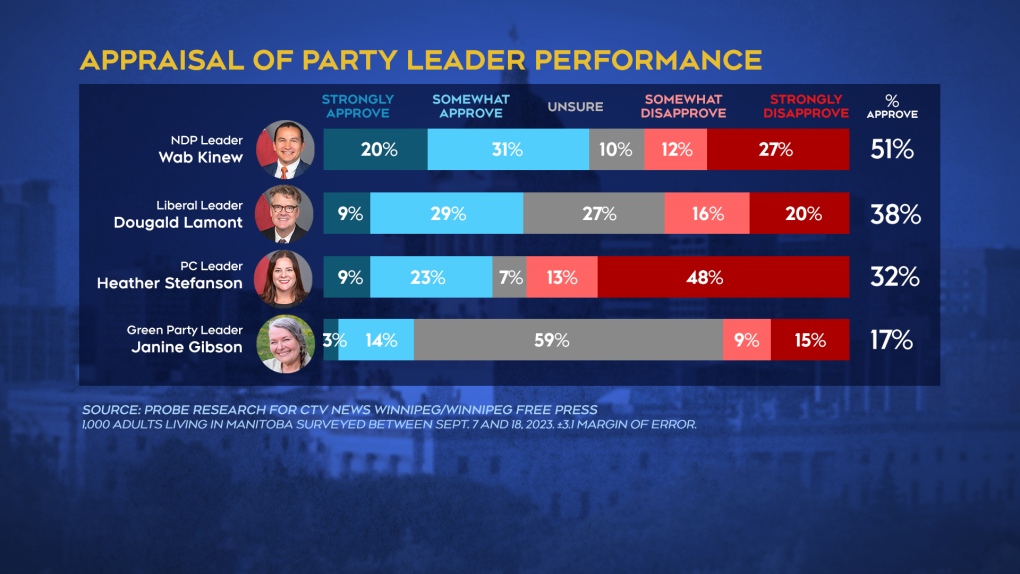
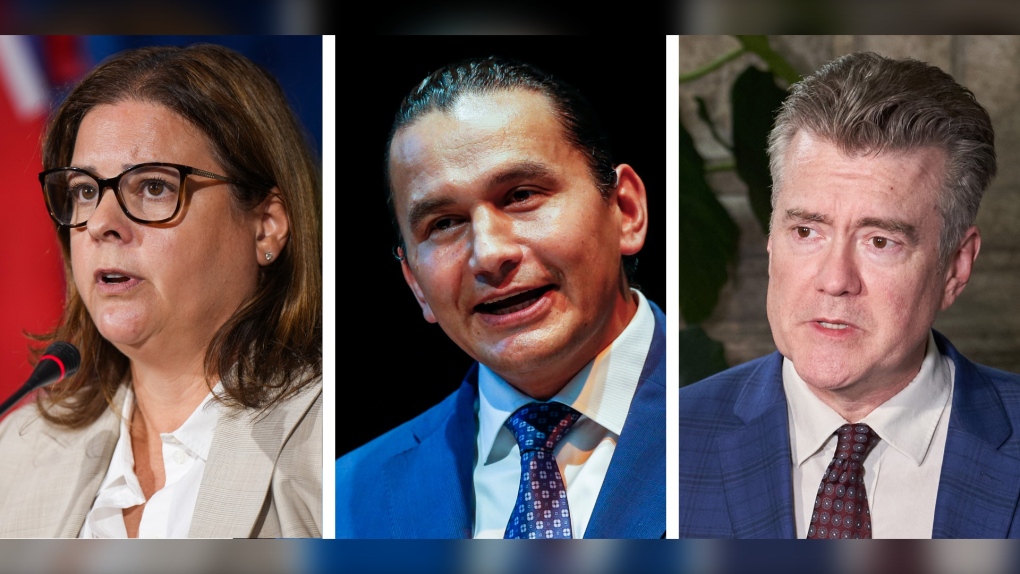
In this composite image made from three photographs, from left to right, Progressive Conservative Party of Manitoba Leader Heather Stefanson speaks during a news conference in Whistler, B.C., Tuesday, June 27, 2023; Manitoba NDP Leader Wab Kinew speaks at the Canadian Mennonite University in Winnipeg, Wednesday, Aug. 16, 2023; and Manitoba Liberal Party Leader Dougald Lamont speaks to the media at the Legislature building, in Winnipeg, Tuesday, March 7, 2023.
Manitoba Election: Kinew and NDP hold six-point advantage at midway mark of campaign

Conservatives viewed as best on economy, NDP on health; NDP viewed as best to form government
September 20, 2023 – Halfway through Manitoba’s provincial election campaign, Manitobans will have a chance to see three party leaders square off in a televised leadership debate Thursday.
As the leaders make their final debate preparations, new data from the non-profit Angus Reid Institute finds the Manitoba NDP holding a six-point advantage over the incumbent Progressive Conservative party, as the two frontrunners for the province’s top job attempt to sway voters over the two defining issues of the campaign – the economy and health care.
Indeed, both of those issues stand out as top priorities across the province and across the political spectrum. For the NDP and leader Wab Kinew, health care appears to be a strength. Two-in-five (40%) Manitoba residents say his party is best to lead the province in this area. That said, when it comes to economic issues, Heather Stefanson’s Progressive Conservatives hold a key advantage. Notably, on both health care and the economy a significant portion of the province say they are not yet sure who is best to steward, suggesting hearts and minds are still to be won on the campaign trail.
The NDP appear to have the upper hand when it comes to leadership. Kinew holds a 17-point advantage in favourability over Stefanson. Further, in the first two weeks of the campaign, Stefanson has significant negative momentum in the eyes of residents (31% say opinions have worsened, 11% opinions have improved), while Kinew has tread water (21% worsened, 23% improved).
Winnipeg represents a stronghold of support for the NDP. In the province’s major urban centre, more than half (53%) say they will vote for their local NDP candidate, compared to the three-in-ten (31%) who support the Manitoba PCs. That said, outside of Winnipeg, the Conservatives hold a 15-point advantage.

More Key Findings:
- The NDP holds a 22-point lead over the Progressive Conservative Party in Winnipeg (53% to 31%), while the PCs hold a significant lead in the rest of the province, 53 per cent to 38 per cent.
- One-in-three prefer Kinew (34%) on the question of which leader would make the best premier. One-quarter choose Stefanson (23%), while fully one-in-five Manitobans say none of the options would make a good premier (21%). Notably, just half (50%) of 2019 PC voters say Stefanson would make the best premier.
- The NDP are chosen as the best party to lead on both Indigenous issues (52% NDP – 15% PC) and LGBTQ2+ issues (31% NDP – 17% PC) by a comfortable margin.
About ARI
The Angus Reid Institute (ARI) was founded in October 2014 by pollster and sociologist, Dr. Angus Reid. ARI is a national, not-for-profit, non-partisan public opinion research foundation established to advance education by commissioning, conducting and disseminating to the public accessible and impartial statistical data, research and policy analysis on economics, political science, philanthropy, public administration, domestic and international affairs and other socio-economic issues of importance to Canada and its world.
INDEX
Part One: Impressions of leadership
Part Two: Priorities and performance
Top issues
PCs viewed as better on economy, NDP on health care
Best to form government
Best premier
Part Three: Vote intention
Age and gender
The regional divide
Voter retention
Three-in-five say they’re voting against a party rather than for one
No comments:
Post a Comment